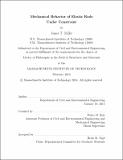| dc.contributor.advisor | Pedro M. Reis. | en_US |
| dc.contributor.author | Miller, James Thomas, Ph. D. Massachusetts Institute of Technology | en_US |
| dc.contributor.other | Massachusetts Institute of Technology. Department of Civil and Environmental Engineering. | en_US |
| dc.date.accessioned | 2014-07-11T17:13:51Z | |
| dc.date.available | 2014-07-11T17:13:51Z | |
| dc.date.copyright | 2014 | en_US |
| dc.date.issued | 2014 | en_US |
| dc.identifier.uri | http://hdl.handle.net/1721.1/88280 | |
| dc.description | Thesis: Ph. D., Massachusetts Institute of Technology, Department of Civil and Environmental Engineering, 2014. | en_US |
| dc.description | This electronic version was submitted by the student author. The certified thesis is available in the Institute Archives and Special Collections. | en_US |
| dc.description | Cataloged from student-submitted PDF version of thesis. | en_US |
| dc.description | Includes bibliographical references (pages 213-223). | en_US |
| dc.description.abstract | We present the results of an experimental investigation of the mechanics of thin elastic rods under a variety of loading conditions. Four scenarios are explored, with increasing complexity: i) the shape of a naturally curved rod suspended under self-weight, ii) the buckling and post-buckling behavior of a rod compressed inside a cylindrical constraint, iii) the mechanical instabilities arising when a rod is progressively injected into a horizontal cylinder, and iv) strategies for mitigation of these instabilities by dynamic excitation of the constraint. First, we consider the role of natural curvature in determining the shape of a hanging elastic rod suspended under its own weight. We categorize three distinct configurations: planar hooks, localized helices, and global helices. Experimental results are contrasted with simulations and theory and the phase diagram of the system is rationalized. Secondly, in what we call the classic case experiment, we study the buckling and post-buckling behavior of a rod compressed inside a cylindrical constraint. Under imposed displacement, the initially straight rod buckles into a sinusoidal mode and eventually undergoes a secondary instability into a helical configuration. The critical buckling loads are quantified and found to depend strongly on the aspect ratio of the rod to pipe diameter. Thirdly, we inject a thin elastic rod into a horizontal cylinder under imposed velocity in the real case experiment. Friction between the rod and constraining pipe causes an increasing axial load with continued injection. Consecutive buckling transitions lead to straight, sinusoidal, and helical configurations in a spatially heterogeneous distribution. We quantify critical lengths and loads for the onset of the helical instability. The geometric parameters of the system strongly affect the buckling and post-buckling behavior. Finally, we explore active strategies for delaying the onset of helical buckling in the real case. Distributed vertical vibration is applied to the cylindrical constraint, which destabilizes frictional contacts between the rod and pipe. Injection speed, peak acceleration of vibration, and vibration frequency are all found to affect the postponement of helical initiation. The process is rationalized and design | en_US |
| dc.description.statementofresponsibility | by James T. Miller. | en_US |
| dc.format.extent | 223 pages | en_US |
| dc.language.iso | eng | en_US |
| dc.publisher | Massachusetts Institute of Technology | en_US |
| dc.rights | M.I.T. theses are protected by copyright. They may be viewed from this source for any purpose, but reproduction or distribution in any format is prohibited without written permission. See provided URL for inquiries about permission. | en_US |
| dc.rights.uri | http://dspace.mit.edu/handle/1721.1/7582 | en_US |
| dc.subject | Civil and Environmental Engineering. | en_US |
| dc.title | Mechanical behavior of elastic rods under constraint | en_US |
| dc.type | Thesis | en_US |
| dc.description.degree | Ph. D. | en_US |
| dc.contributor.department | Massachusetts Institute of Technology. Department of Civil and Environmental Engineering | |
| dc.identifier.oclc | 881691695 | en_US |
